This Lemon Cake recipe is the ultimate dessert for lemon lovers made with velvety lemon cake, tangy-sweet lemon curd and lemon cream cheese frosting!
PIN THIS RECIPE TO SAVE FOR LATER
HOW TO MAKE Lemon Cake REcipe VIDEo
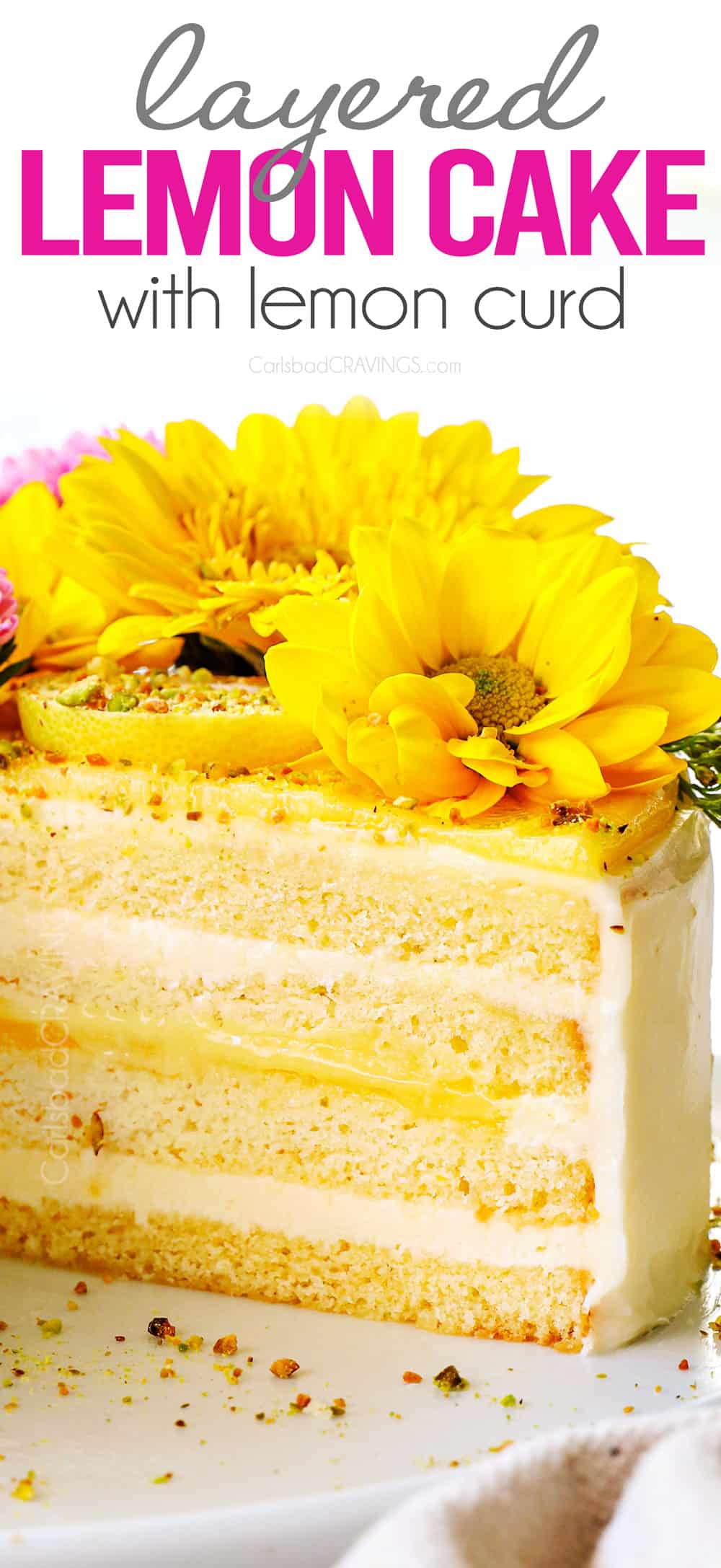
This Lemon Cake recipe is a show stopping dessert everyone will be raving about and destined to become one of your favorite cakes of all time – it is mine! The cake is soft and airy thanks to the reverse-creaming method, infused with bright fresh lemon flavor, layered with luscious, zingy-sweet lemon curd and lemon curd infused cream cheese frosting! It is a show stopping dessert for every occasion and 100% make ahead friendly. Tips and tricks, Step-by-Step Photos and Video, How to Make Ahead, How to Freeze all included!
Lemon desserts are my favorite bright and fresh desserts in the spring and summer! Don’t miss these favorites: Lemon Blueberry Cake, Lemon Pound Cake, Lemon Cheesecake, Lemon Cheesecake Bars, Lemon Pound Cake and Lemon Curd.

Why This Lemon Cake Recipe Works
This Lemon Cake recipe is the result of my niece’s request for “lemon cake” for her 8th birthday. And I’m so glad she did. It’s one of my favorite cakes of all time, only slightly adapted from my Lemon Blueberry Cake recipe (with tons of rave reviews). Here’s why it works:
Perfectly balanced: The cake is not too tart, not too sweet, but the adept balance of fresh, tangy sweetness that makes you want to lick the plate.
The lemon curd: This cake is velvety sunshine from the cake to the lemon curd to the frosting. But truly, it’s the exquisite
silky smooth, bright, zingy, lemon curd that is spoon worthy on its own, that truly makes this one of the most irresistible cakes ever.
The reverse creaming method: What sets the texture of this Lemon Cake recipe apart is the reverse creaming method. After dozens of experiments, Baking Illustrated concluded that instead of creaming the butter and sugar as usual, if you work the butter into the flour and then whisk in the milk/egg mixture, you don’t get an over-glutenized, dry cake which leads to…
The most tender, delicate cake: The reverse creaming method creates a velvety, soft, moist, ultra-light cake with structure but without toughness. You will be blow away at how melt-in-your mouth tender the cake is!


About the Lemon Curd
The star of this Lemon Cake recipe AKA the secret to its intense sweet-tart lemon flavor is the rich, silky smooth, creamy, wonderfully buttery lemon curd. If you’ve never made lemon curd before, don’t worry, this recipe is:
Easy! You don’t need a double broiler or to zest a ton of lemons, all you need is lemon juice, eggs, sugar, vanilla extract, butter and a saucepan – everything we are using already for our Lemon Cake!
Sturdy. The lemon curd is rich and creamy but sturdy enough to spread over the cake without leaking out the sides, even when sliced. The secret? Adding a bit of cornstarch to the eggs and finishing with cold butter at the end.
Make ahead. This recipe can be made ahead of time because it keeps for up to 4 weeks in the fridge or up to one year in the freezer. But warning, if you make it ahead of time, there might not be any left when you need it!
Best LEMON CAKE INGREDIENTS
The ingredient list for this recipe appears lengthy but most of the ingredients are pantry friendly staples and used multiple times in the cake, curd and/or frosting. Here’s what you’ll need for each component (exact measurements in the printable recipe card at the bottom of the post):
For the cake
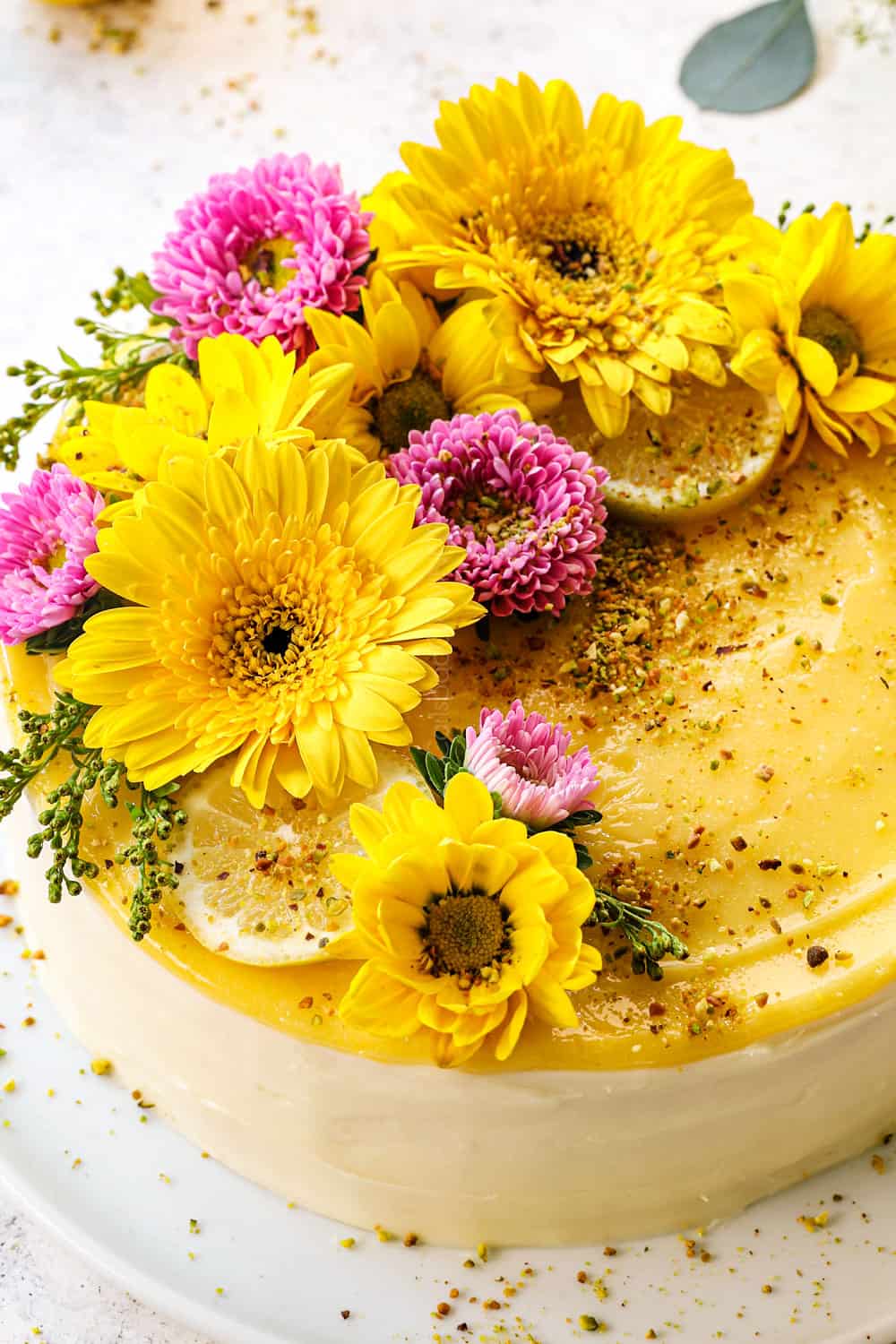

HOW TO MAKE YOUR OWN CAKE FLOUR
For this recipe, substitute the cake flour with 1 ¾ cup all-purpose flour and ¼ cup cornstarch. Sift the flour and cornstarch together in a large bowl, then repeat sifting 2-3 times more to aerate the mixture so it’s closer to the consistency of real cake flour.
‘
FOR THE LEMON CURD
Making homemade Lemon Curd is easy with this recipe! You will need many of the same ingredients you used for the cake:
- Lemons: For the best zingy and citrusy flavor, Lemon Curd should be made with freshly squeezed lemon juice. We will use a full 2/3 cup freshly squeezed lemon juice which is about 3-4 large lemons.
- Eggs: Eggs help the curd hold together like pudding. You will need 4 large eggs and 2 large egg YOLKS only for a total of 6 eggs for the lemon curd.
- Butter: This is essential to help thicken the curd and makes it super creamy, rich and decadent with a velvety mouthfeel and subtle buttery flavor. Use unsalted butter or omit the salt in the recipe.
- Sugar: This provides the balancing sweetness to the tart lemon juice. Please use only granulated sugar or the flavor and consistency will be ruined.
- Salt: A pinch of salt balances the flavors. Use regular table salt and not anything larger.
- Cornstarch: Set yourself up for lusciously thick and smooth success with this secret weapon. Cornstarch not only ensures the curd thickens properly but more importantly, it binds to the egg proteins and acts to protect them from denaturing, helping to prevent your curd from curdling.
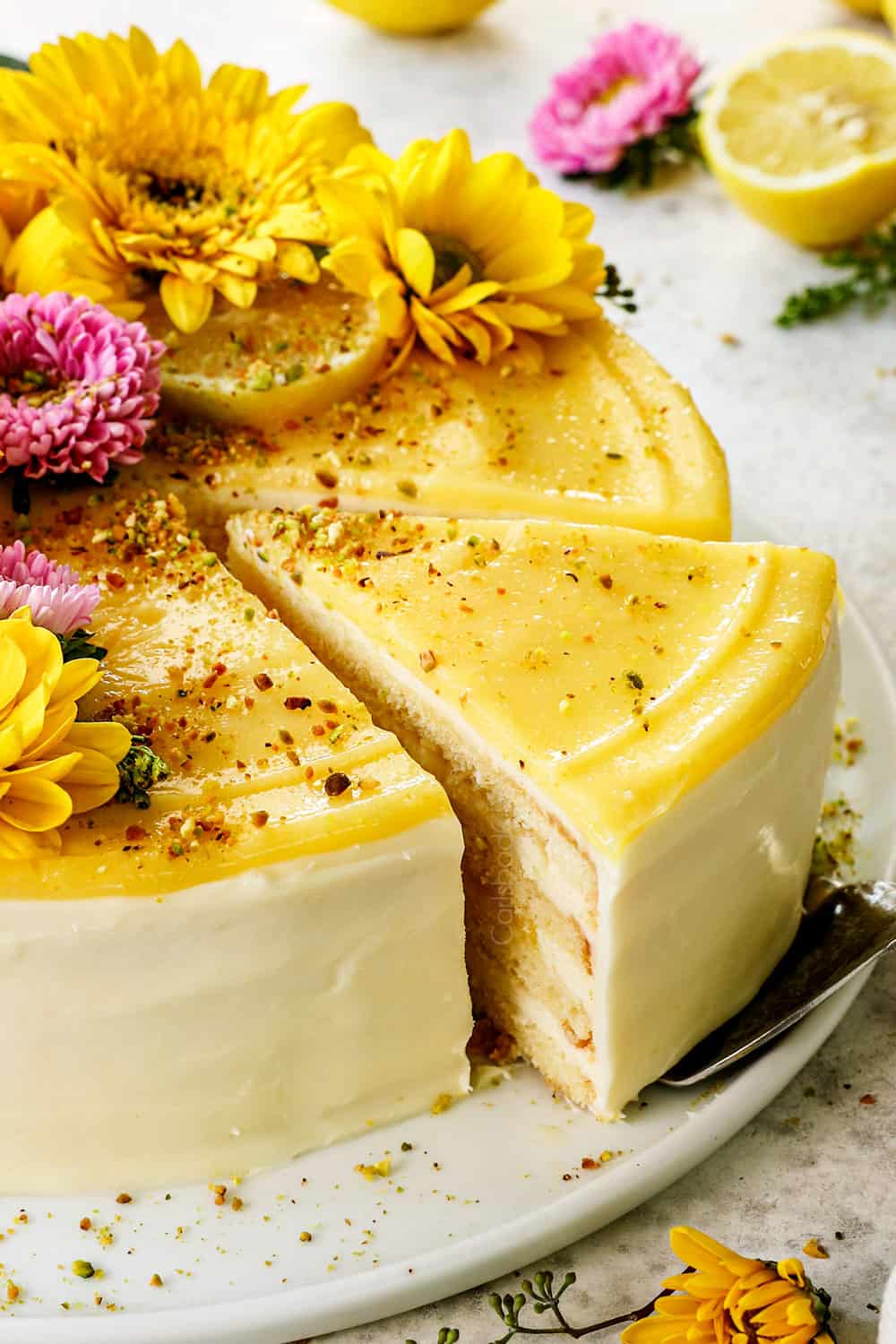

Can I use store-bought lemon curd?
Yes, you will need two cups for this Lemon Cake recipe. You can you use store bought lemon curd (which can usually be located by the jams/jellies) but I promise making your own with my recipe is so easy, tastes 100X better, contains nothing but pure ingredients and comes together in less than 10 minutes (plus chilling)!
FOR THE LEMON CREAM CHEESE FROSTING
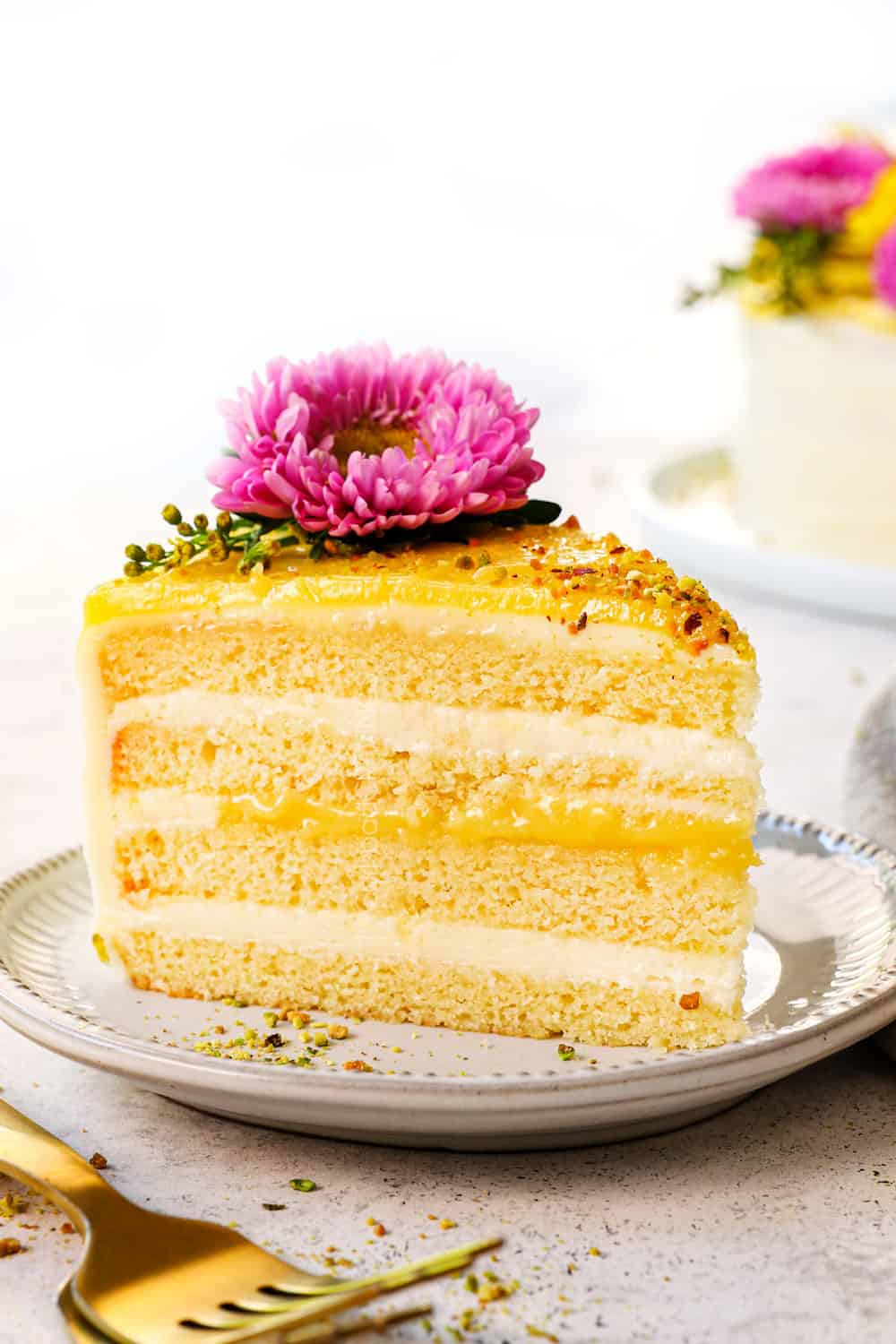

TIPS FOR PICKING LEMONS
Lemons are the star of the show, so let’s pick good ones! You will need 4-5 medium lemons for this recipe.
Look for lemons that are bright yellow without soft spots, have a clean sharp citrussy fragrance, are heavy for their size, yield slight when gently squeezed and are smaller, which means they have thinner skins and are best for juicing.

Why Do I have to use room temperautre ingredients?
You’ve heard it here many times, and no doubt in other recipes, so why use room temperature ingredients when baking a cake? Is it that important? The answer is YES! It is essential that you use room temperature eggs, milk, lemon juice and butter for this recipe or your cake will not rise properly or be as tender. Here’s why:
1. Room temperature ingredients bind together more easily than if you had some cold and some warmer ingredients – you can literally feel the difference when mixing by hand. In other words, the batter is easier to NOT overmix and overwork the gluten, which creates more even lift and rise in the cake when baking.
2. Cold ingredients require longer to bind together so they are easy to overmix which over-develops the gluten making a denser cake.
Cold eggs and milk can break the emulsion of the sugar and butter, so the batter loses air cells, resulting in a baked cake that is grainy or flat in texture, dry or dense.
3. Cold ingredients also produce a thicker, colder batter which takes longer to bake which changes the entire structure and texture of the cake.

How to Make the Best Lemon Cake
This Lemon Cake recipe with its irresistible bright, fresh, tangy lemon flavor, mega moistness and silky layers of lemon curd and lemon cream cheese frosting is truly ethereal and worth every second of making. The main tip for making this cake (see entire tips and tricks section to follow) is to give yourself time because the recipe benefits from chilling at multiple stages.
Let’s take a closer look at how to make this Lemon Cake or watch the How to Make Video in the recipe card (full recipe measurements in the printable recipe card at the bottom of the post):
STEP 1: MAKE THE LEMON CURD
This is the easiest technique I have found for making lemon curd. The key is to work over medium-low heat and to whisk constantly. You can also watch the How to Make Video in my Lemon Curd post.
- Combine the ingredients: Whisk the lemon juice, lemon zest, sugar, cornstarch and eggs in a small saucepan until the cornstarch dissolves and most of the sugar has dissolved.
- Thicken the lemon curd: Cook over medium-low heat, stirring constantly, until thickened, about 4-8 minutes. You’ll know the lemon curd is done when it’s the consistency of pourable pudding and the curd registers about 180°F on an instant-read thermometer. It will continue to thicken as it cools.
- Stir in the butter: Once thickened, immediately remove the saucepan from the heat and stir in the cubed butter until melted, followed by the vanilla and salt. At this point you can taste and add additional lemon zest for tangier if you’d like.
- Strain the lemon curd: Finally, strain the curd through a fine-mesh strainer/sieve into a small bowl to remove any small egg bits and you have rich, creamy, sweetly tart lemon curd. The lemon curd will thicken and taste even more intensely glorious once chilled.

STEP 2: MAKE THE CAKE BATTER
- Combine the wet ingredients: Whisk the eggs, milk, lemon juice, lemon zest, and vanilla extract together in a 3-cup (or more) liquid measuring cup. Set aside.
- Reverse creaming method: Using a stand mixer fitted with paddle attachment, mix the cake flour, sugar, baking powder and salt on the lowest speed until combined, then add the butter one piece. Increase the speed to medium and continue to beat until the mixture resembles coarse meal.
- Add the wet ingredients: Add approximately half of the egg mixture to the flour mixture. Increase speed to medium-high and beat until light and fluffy, approximately 60 seconds. Reduce speed to medium-low and add remaining egg mixture and beat until incorporated.
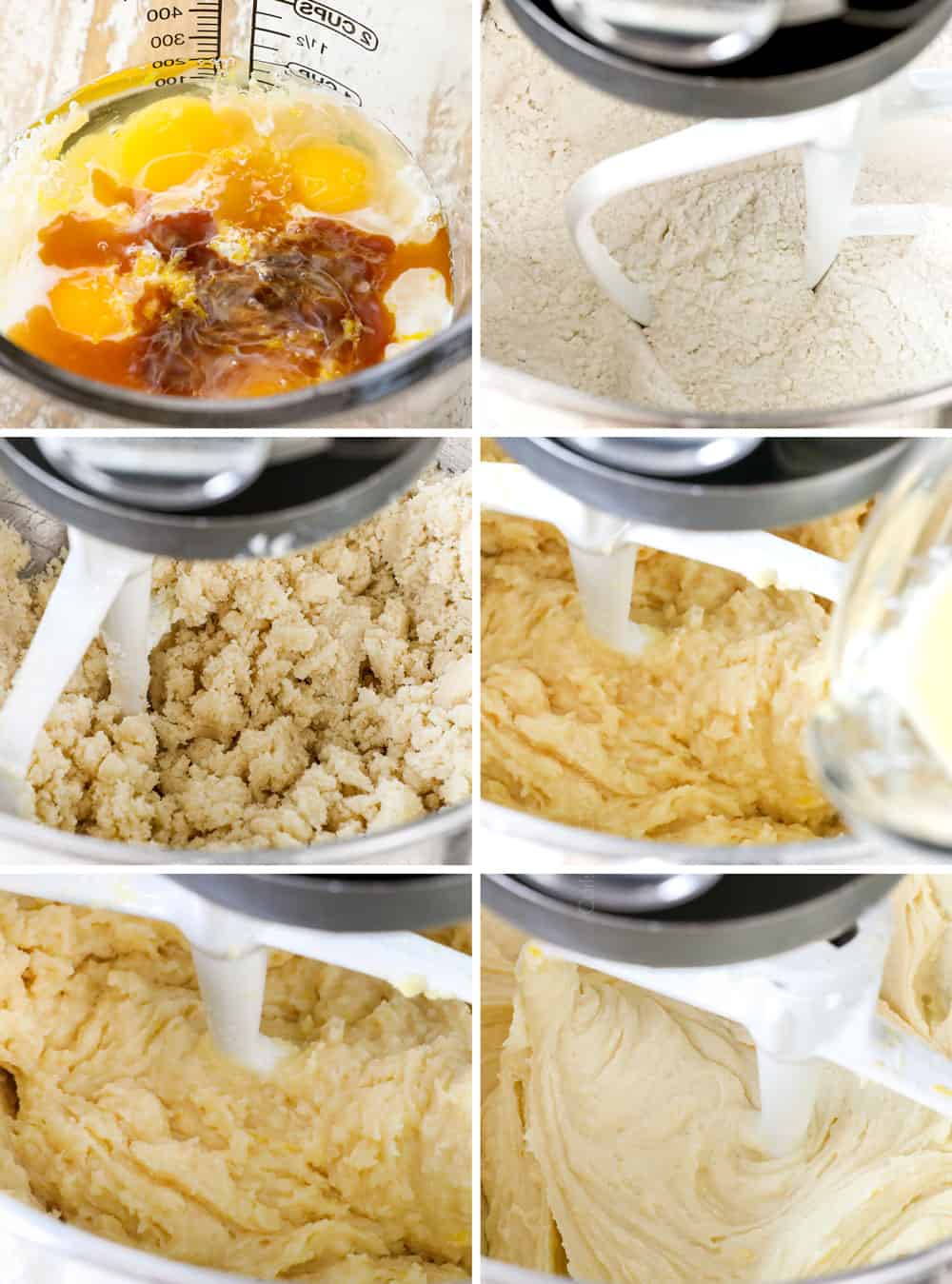
STEP 3: BAKE THE CAKES
- Bake: Divide the batter evenly between the cake pans (I use a kitchen scale), and bake at 350 degrees F for 20-25 minutes.
- Cool. Allow the cakes to cool in pans for 10 minutes then remove cakes to a wire rack and let cool completely.
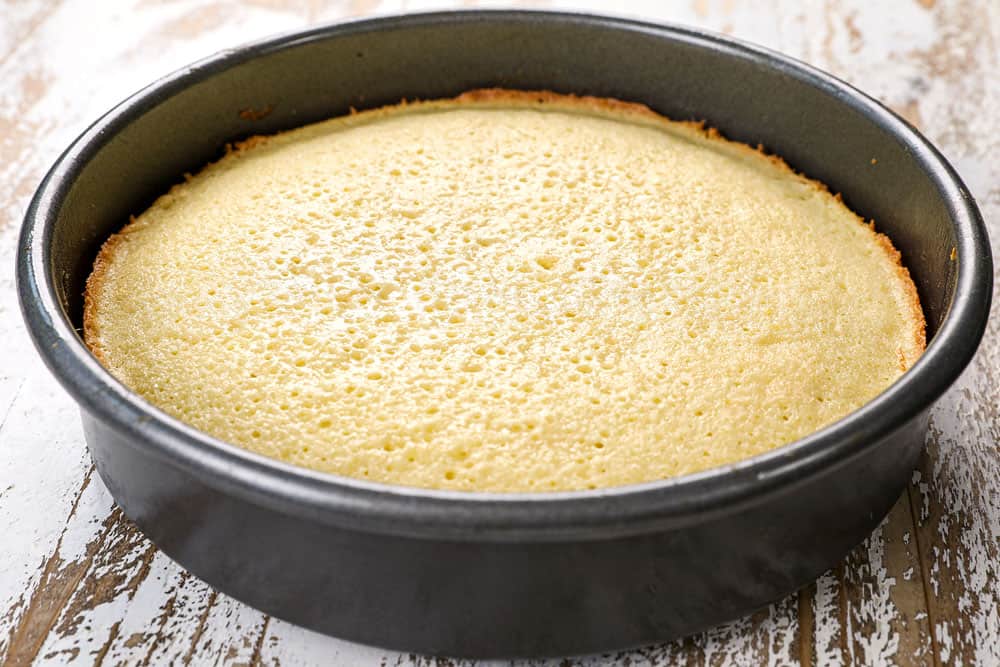
sTEP 4: MAKE THE FROSTING
- Beat the ingredients together: Using a handheld mixer, beat the cream cheese and butter together until very creamy. Beat in ¼ cup lemon curd (from chilled Lemon Curd you made), lemon juice, vanilla extract and salt until smooth.
- Add the powdered sugar: Gradually beat in the powdered sugar then continue to beat until smooth and fluffy.
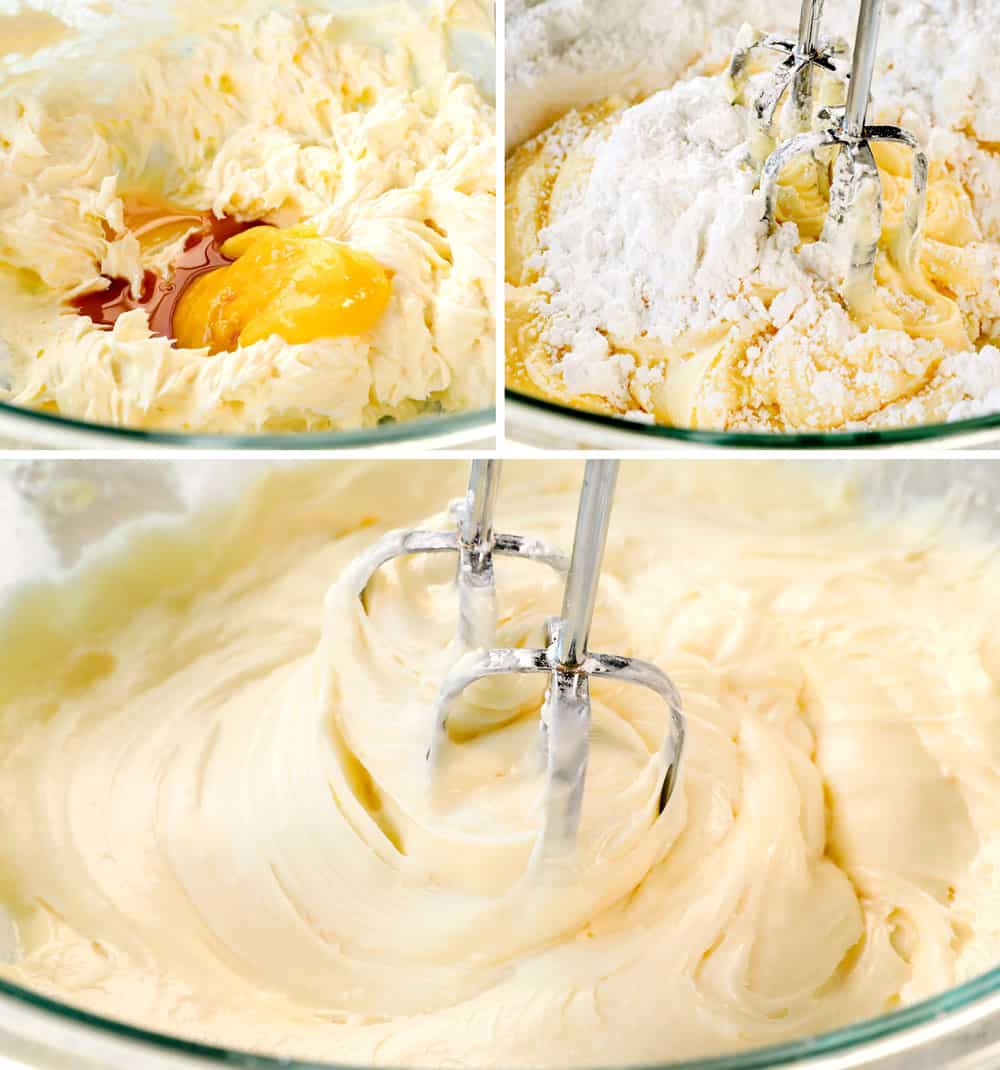
STEP 5: ASSEMBLE THE CAKE
- Cut the cakes in half: Slice the cakes horizontally through the equator using a long-serrated knife to create 4 even layers.
- Layer 1 – Frosting: Place one layer, cut side up, on a serving plate or cake pedestal. Transfer some frosting to a piping bag. Pipe a ring of frosting just inside the top edge of the first cake then evenly fill with a generous amount of Frosting (about one heaping cup). Note: The piping is helpful but optional if you don’t own piping tips.
- Layer 2 – Lemon curd: Top with the 2nd cake layer, top side down. Pipe a ring of frosting just inside the top edge of the cake then fill with half of the chilled Lemon Curd.
- Layer 3 – Frosting: Add the third layer, and repeat piping a ring of frosting and evenly filling with about one heaping cup of Frosting. Add final cake, top side down.
- Chill: Time permitting, place the cake in the refrigerator for 2 hours (cover if refrigerating longer) or the freezer for 30 minutes for the frosting to chill and harden a bit. This interim step means there isn’t any chance of the top layer sliding around on slick warm frosting as you try to apply your crumb coat.


TIPS FOR Cutting Cakes in Half
1. Before cutting your cakes in half, it helps tremendously to pop them in the freezer for 20-40 minutes.
2. Next, place the cakes on a cutting board so they are nice and sturdy.
3. Now, get way down so you’re eye level with the cake and turn your head sideways so you can see on both sides of the knife (be sure to use a serrated knife!).
4. Score the cake evenly in half all around the edges – this create a guideline for the final cut.
5. Finally, slice a little through the guidelines without going all the way through as you work around the cake. This way, you are not slicing straight through the cake and coming up uneven on the other side.
Purchase a cake leveler: all that being said, I did just purchase this cake leveler!
Step 6: FROST CAKE
- Crumb coat: If your cake is sufficiently chilled, you may find you don’t need a crumb layer because a chilled cake does not produce many crumbs. To make a crumb coat, separate about ¾ cup frosting and frost the cake starting with the top and working down until the cake is evenly, thinly frosted.
- Frost cake: Frost the outside of cake as you desire with the remaining frosting, then evenly spread remaining Lemon Curd on top of the cake.
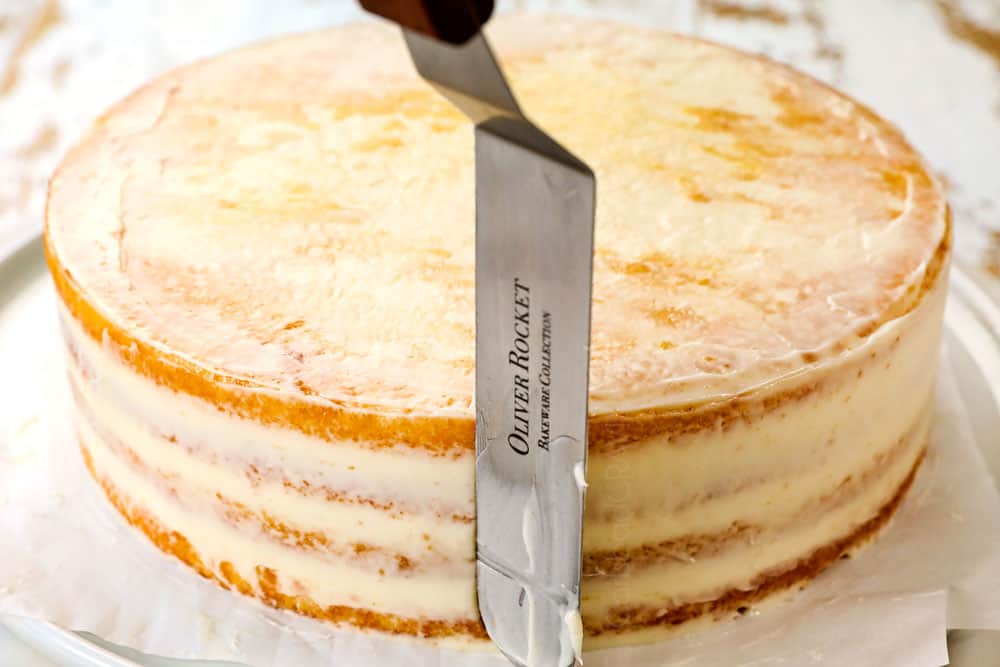

The secret to Successfully Frosting your Cake
Chill your cake again and again! Chilling firms up all of the components of the cake so they don’t slide around:
-Chill the lemon curd for at least 2 hours before using
-Chill the cakes before slicing in half to help firm them up
-Chill the cakes after frosting the layers but before adding the crumb coat
-Chill the cake after frosting so it’s a breeze to slice
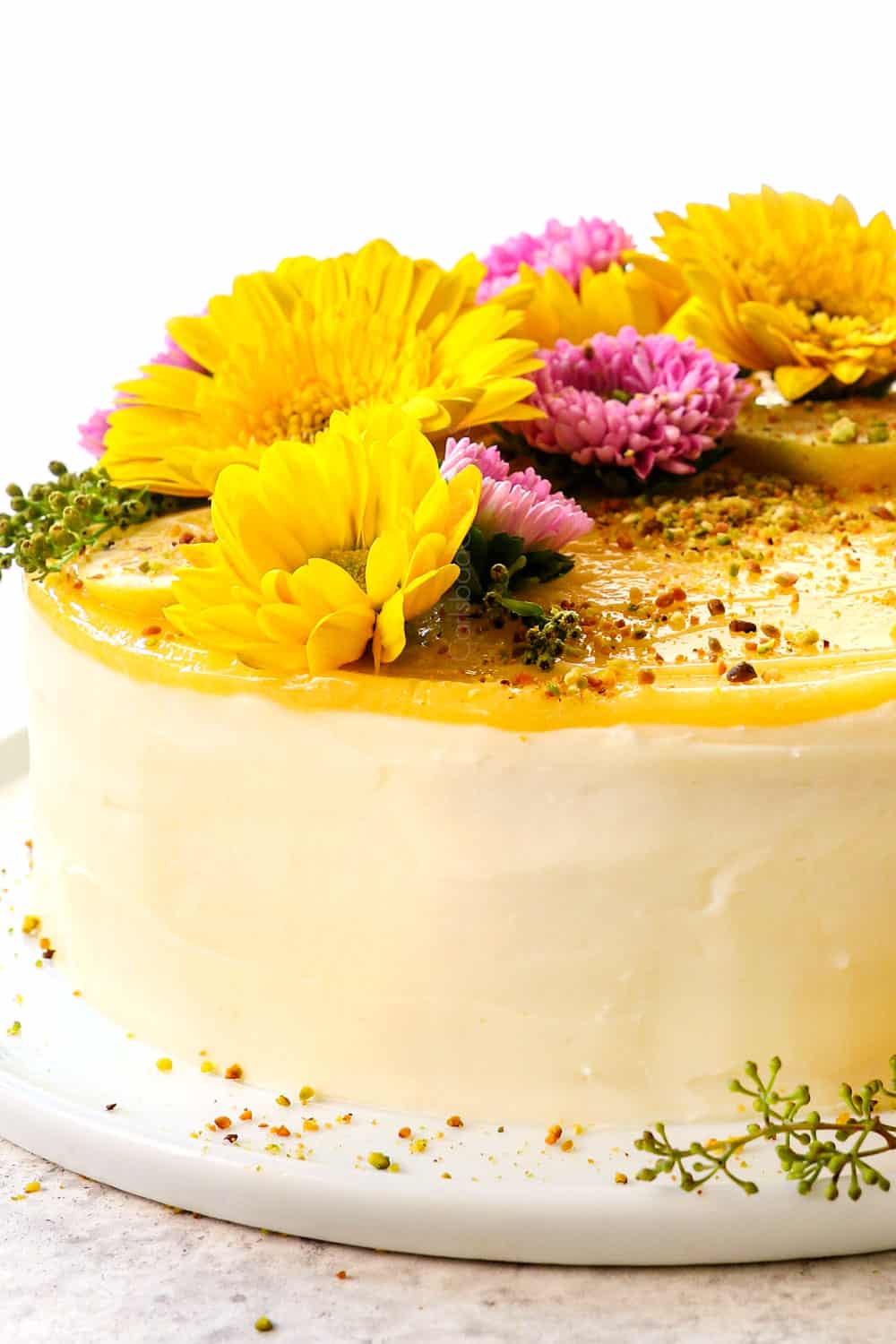
STEP 7: CHILL and Slice
- Chill: Freeze the cake for 30 minutes to firm up before slicing, or if not serving immediately, refrigerate until ready to slice.
- Slice: Slice, then serve the cake at room temperature, or pop slices in the microwave for no longer than 8-10 seconds.


Tips for MAking the Best Lemon Cake
There are a few components to this Lemon Cake recipe with the cake, lemon curd and frosting, but each step is simple when taken one at a time. As always, I suggest reading the recipe all the way through, allowing plenty of time and gathering your ingredients. Here are all the tips and tricks you need for a runaway, light and lemony, ultra-tender success!
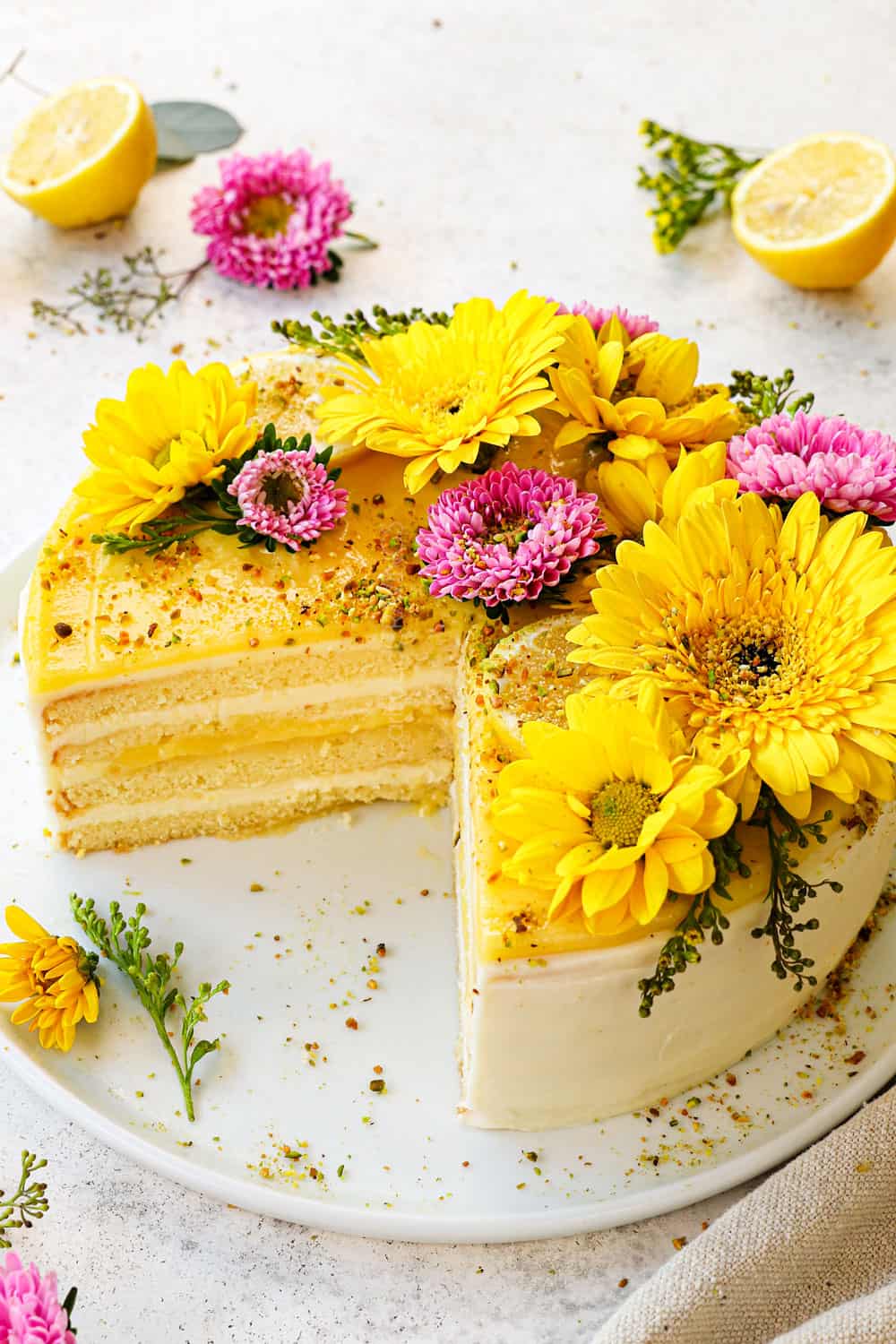

possible recipe variations
This Lemon Cake recipe is extremely versatile so you can bring your personal taste and mood every time you make it! You can add berries to the top or use the recipe as a springboard to make lemon blueberry cake, lemon poppy seed cake, lemon almond cake or lemon pistachio cake. Here are just a few ideas:
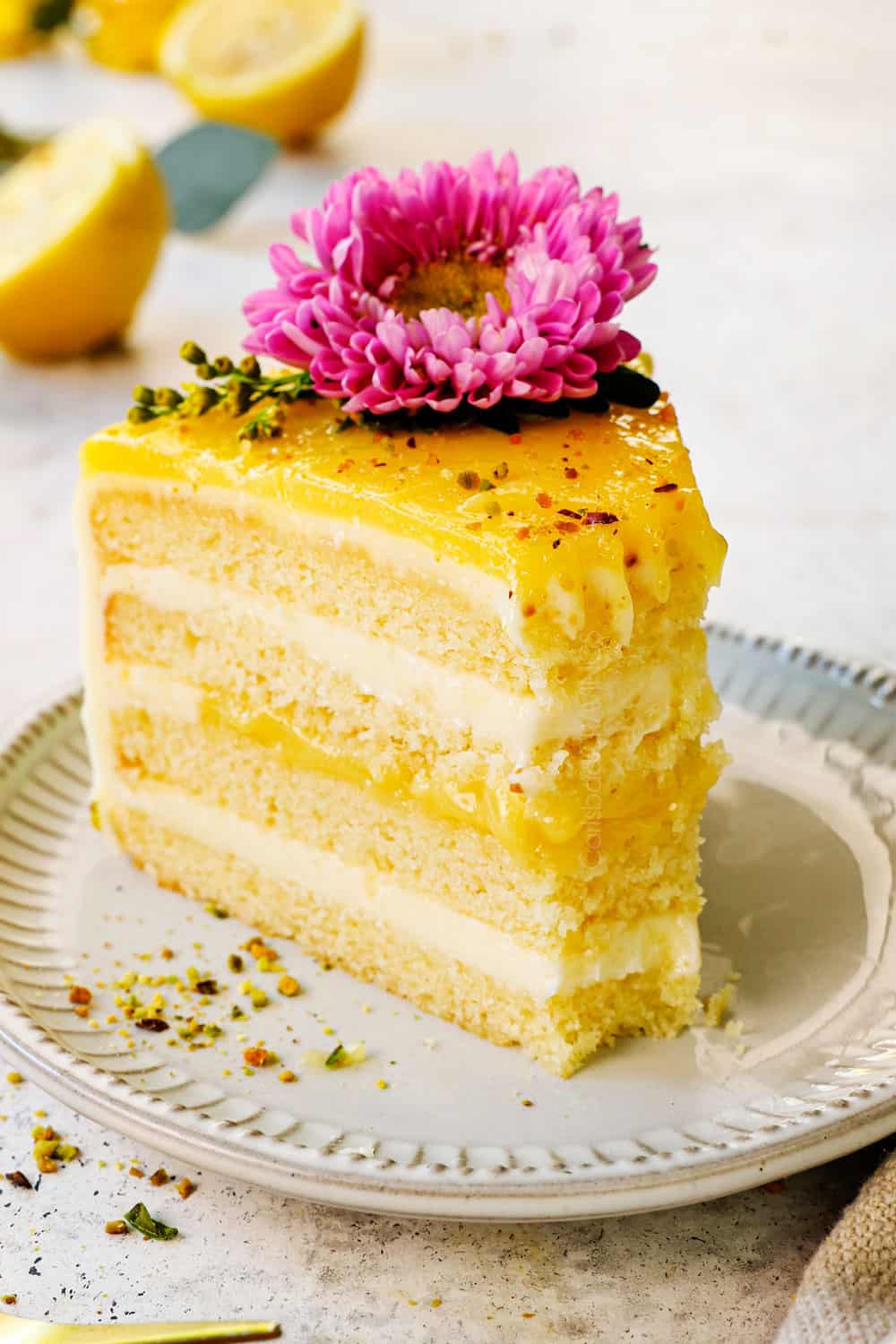

MAke Ahead Lemon Cake
You can make the cake entirely ahead of time, or in stages, here’s how:
Lemon Curd: According to the National Center for Home Food Preservation, Lemon Curd will keep in an air tight container in the refrigerator for up to four weeks. Of course, always use your best judgement. Lemon Curd freezes well for up to one year without any change in quality.
Frosting: Can be made up to 24 hours, covered and refrigerated. Let it come close to room temperature before re-whipping if needed.
Cakes: The cake layers can be made, cooled, and wrapped tightly in plastic wrap and refrigerated one day in advance or frozen for up to 3 months.
Crumb Coated Cake: Let the crumb coat set completely (about 1 hour in the freezer or 2 hours in the refrigerator), then tightly wrap the cake in plastic wrap and refrigerate or freeze until ready to finish frosting.
Frosted Cake: Assemble the entire cake, cover with a cake cover or tent with foil then refrigerate for 24 hours before slicing, then allowing to sit at room temperature for 1-2 hours before serving.

HOW TO STORE lemon cake
The assembled and frosted cake should be covered with a cake cover or foil and refrigerated. It may be stored for up to 5 days, but is at peak freshness the first two days. Slice the cake, then bring to room temperature before serving or microwave individual slices for 8-10 seconds.
HOW TO Freeze
To freeze individual cake layers: Tightly wrap the individual cake layers in plastic wrap and freeze for up to three months.
To freeze crumb coated cake: Tightly wrap the set cake in a couple layers of plastic wrap followed by a couple layers of foil, freeze for up to two months.
To freeze frosted cake: Flash freeze the cake until solid, then tightly wrap in a couple layers of plastic wrap followed by a couple layers of foil, freeze for up to two months. Remove the plastic wrap, transfer to a cake container and allow to thaw overnight in the refrigerator before slicing. After slicing, let come to room temperature before serving.

WANT TO TRY THIS Lemon Cake RECIPE?
PIN IT TO YOUR Cake or Dessert recipe BOARD TO SAVE FOR LATER!
FIND ME ON PINTEREST FOR MORE GREAT RECIPES! I AM ALWAYS PINNING :)!
©Carlsbad Cravings by CarlsbadCravings.com

Lemon Cake
Save This Recipe To Your Recipe Box
You can now create an account on our site and save your favorite recipes all in one place!
Ingredients
CAKE
- 4 large eggs, room temperature
- 1/3 cup milk (anything but nonfat), room temperature
- 2 tablespoons lemon juice, room temperature
- 1 tablespoon lemon zest
- 2 teaspoons vanilla extract
- 2 cups cake flour (See DIY in Notes)
- 1 1/2 cups granulated sugar
- 2 teaspoons baking powder
- 3/4 teaspoon salt
- 16 tablespoons unsalted butter cut into 16 pieces, room temperature
LEMON CURD (MAY USE STORE BOUGHT) ***
- 1 recipe lemon curd (or 2 cups store-bought)
LEMON CREAM CHEESE FROSTING
- 12 ounces full fat cream cheese, room temperature (don't microwave!)
- 1 cup unsalted butter, room temperature (don't microwave!)
- 1/4 cup chilled lemon curd, from above (in directions)
- 1 tablespoon lemon juice
- 1/2 teaspoon vanilla extract
- pinch of salt
- 3 1/2 cups powdered sugar
Instructions
LEMON CURD
- Prepare the lemon curd according to recipe directions (click here). It must chill for at least 2 hours in the refrigerator before using. It can be made up to three weeks ahead of time and stored in an airtight container in the refrigerator.
CAKE
- Preheat oven to 350 degrees F. Line the bottom of two 9-inch cake pans with parchment paper. Spray with nonstick cooking spray WITH flour or butter and flour the pans.
- Whisk the eggs, milk, lemon juice, lemon zest, and vanilla extract together in a 3-cup (or more) liquid measuring cup. Set aside.
- Using a stand mixer fitted with paddle attachment, mix the cake flour, sugar, baking powder and salt on the lowest speed until combined, about 20 seconds. With the mixer still running at the lowest speed, add 1 piece of butter at a time and continue to beat until all the butter is added. Increase speed to medium and continue to beat until the mixture resembles coarse meal, with butter bits no larger than small peas.
- With the mixer running on low, add approximately half of the egg mixture to the flour mixture. Increase speed to medium-high and beat until light and fluffy, approximately 60 seconds. Reduce speed to medium-low and add remaining egg mixture and beat until incorporated, about 30 seconds (batter may look slightly curdled.) DO NOT OVERMIX.
- Divide the batter evenly between the prepared cake pans, smooth with a spatula and drop a few times on the counter to remove air bubbles. Bake at 350 degrees F for 20-25 minutes or until a toothpick inserted in the center of the cakes comes out clean.
- Cool the cakes in pans for 10 minutes then remove cakes to a wire rack and let cool completely.
- Time permitting, after cooling, freeze the cakes for 30-60 minutes to make them easier to slice in half. (Make ahead: Alternatively, tightly wrap the cooled cakes in plastic wrap at this point and refrigerate until ready to slice and frost.)
FROSTING
- Using a handheld mixer, beat the cream cheese and butter together at medium speed until very creamy. Beat in ¼ cup lemon curd (from chilled Lemon Curd you made), lemon juice, vanilla extract and salt until smooth.
- Gradually beat in powdered sugar then continue to beat at medium-high speed until smooth and fluffy. If frosting is too runny, then refrigerate until more set.
ASSEMBLE
- Place four strips of parchment paper around the edges of a plate or cake stand to create a square with an open space in the middle (to keep cake stand clean).
- Cut cakes in half horizontally using a long-serrated knife or cake leveler to create 4 even layers. Place 1 layer, cut side up, on the prepared serving plate/cake stand.
- Transfer some frosting to a piping bag (or ziploc bag). Pipe a ring of frosting just inside the top edge of the first cake then evenly fill with a generous amount of frosting (about one heaping cup) and spread into an even layer. (Note: The piping ring is helpful but optional if you don't have piping tips.)
- Top with the 2nd cake layer, top side down. Pipe a ring of frosting just inside the top edge of the cake then fill with half of the chilled Lemon Curd and spread into an even layer.
- Add the third cake layer and repeat piping a ring of frosting and evenly filling with about one heaping cup of frosting and spreadig into an even layer.
- Add final cake, top side down.
- Time permitting, place the cake in the freezer for 15-30 minutes for the frosting to chill and harden a bit. This interim step prevents the top layer from sliding around on slick warm frosting as you try to apply your crumb coat. (Make Ahead: Alternatively, cover the cake with plastic wrap and refrigerate until you're ready to continue.)
FROST CAKE
- Crumb coat: Separate about ¾ cup frosting to use as the “crumb coat.” Frost the cake starting with the top and working down until the cake is evenly, thinly frosted. Freeze the cake for 15-30 minutes or until the crumb layer has set.
- Frost cake: Frost the outside of cake as you desire with the remaining frosting, then evenly spread remaining chilled Lemon Curd on top of the cake. Decorate the top of the cake if desired (I used fresh flowers and crushed pistachios).
CHILL THEN SLICE
- Freeze the cake for 20-30 minutes to firm up before slicing, or if not serving immediately, refrigerate for at least 45 minutes. Slice, then serve at room temperature, or pop chilled slices in the microwave for no longer than 8-10 seconds.
STORE
- The frosted cake should be covered with an inverted bowl or cake cover and refrigerated. Slice while chilled, but bring cake to room temperature before serving.
Video
Notes
Tips for And Tricks
- Read the recipe: There are a few components to this recipe, but each step is simple when taken one at a time. As always, I suggest reading the recipe all the way through and allowing plenty of time.
- Start the lemon curd first – or don’t. The lemon curd needs 2 hours to chill before using, so if you’re in a time crunch, make it very first so you can get it in the refrigerator as soon as possible. If you have more time, then make it while your cake is baking or cooling. I typically do the latter and then refrigerate both the cakes and lemon curd until the next day.
- Thicken the lemon curd enough: You’ll know the lemon curd is done when it’s the consistency of pourable pudding and registers 180°F on an instant-read thermometer. A thermometer is so helpful for this and eliminates all of the guesswork!
- Use room temperature ingredients: Room temperature ingredients help the emulsion be more successful between the butter, sugar and eggs, or in other words, they will mix much easier together (so it’s harder to overmix and over-activate the gluten) and whisk to a higher volume which results in a softer cake with maximum volume.
- Room temperature eggs hack: Add warm (not hot) tap water to a bowl then add eggs (still in their shells) for at least 20 minutes.
- Don’t microwave your butter: It is important that the butter be softened at room temperature and not microwaved because we want soft but not warm butter. Also, don’t forget to slice your butter before softening – it’s much easier this way!
- Don’t pack the flour: Whenever you measure flour, don’t scoop it into the flour bag/container or else the flour will compress; packed flour yields denser, drier cakes. Rather, scoop the flour into a measuring cup and then level.
- Beat the batter until fluffy: Make sure to beat the flour with half of the egg mixture until fluffy in order to aerate the batter, otherwise your cakes won’t rise in the oven.
- Divide the cakes evenly: I use a kitchen scale to measure each pan and adjust as needed. This will create even cakes with the most even layers.
- Don’t microwave the cream cheese or butter: For the frosting, use cream cheese and butter softened at room temperature, to room temperature. If you soften either in the microwave, your frosting will be runny and create a wobbly mess.
- Don’t skip chilling before slicing: Due to the lemon curd, the cake is much easier to slice when chilled, otherwise, the cake can fall apart/layers squeeze out, under the pressure of the knife.
Make Ahead
This cake can be made entirely ahead of time or it is easy to make in stages:- Lemon Curd: According to the National Center for Home Food Preservation, Lemon Curd will keep in an air tight container in the refrigerator for up to four weeks. Of course, always use your best judgement. Lemon Curd freezes well for up to one year without any change in quality.
- Frosting: Can be made up to 24 hours, covered and refrigerated. Let it come close to room temperature before re-whipping if needed.
- Cakes: The cake layers can be made, cooled, and wrapped tightly in plastic wrap and refrigerated one day in advance or frozen for up to 3 months.
- Crumb Coated Cake: Let the crumb coat set completely (about 1 hour in the freezer or 2 hours in the refrigerator), then tightly wrap the cake in plastic wrap and refrigerate or freeze until ready to finish frosting.
- Frosted Cake: Assemble the entire cake, cover with a cake cover or tent with foil then refrigerate for 24 hours before slicing, then allowing to sit at room temperature for 1-2 hours before serving.
How to Store and Freeze
- To store: The assembled and frosted cake should be covered with a cake cover or foil and refrigerated. It may be stored for up to 5 days, but is at peak freshness the first two days. Slice the cake, then bring to room temperature before serving or microwave individual slices for 8-10 seconds.
- To freeze individual cake layers: Tightly wrap the individual cake layers in plastic wrap and freeze for up to three months.
- To freeze crumb coated cake: Tightly wrap the set cake in a couple layers of plastic wrap followed by a couple layers of foil, freeze for up to two months.
- To freeze frosted cake: Flash freeze the cake until solid, then tightly wrap in a couple layers of plastic wrap followed by a couple layers of foil, freeze for up to two months. Remove the plastic wrap, transfer to a cake container and allow to thaw overnight in the refrigerator before slicing. After slicing, let come to room temperature before serving.

Did You Make This Recipe?
Tag @CarlsbadCravings and Use #CarlsbadCravngs
Leave a Review, I Always Love Hearing From You!

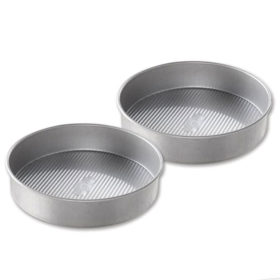
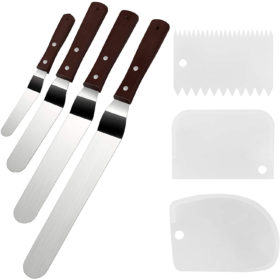
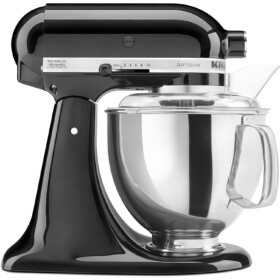





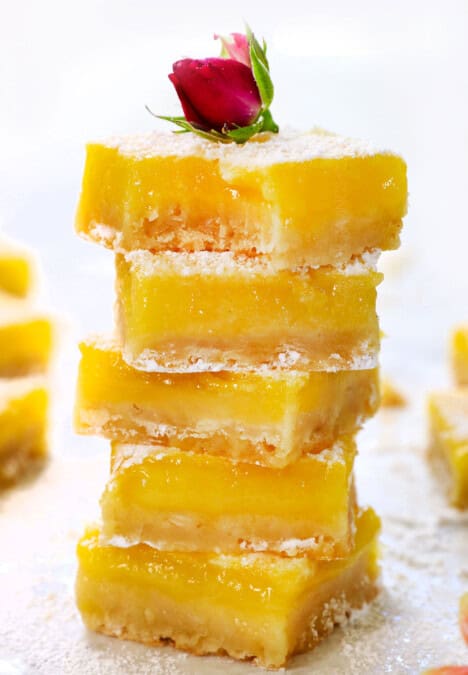
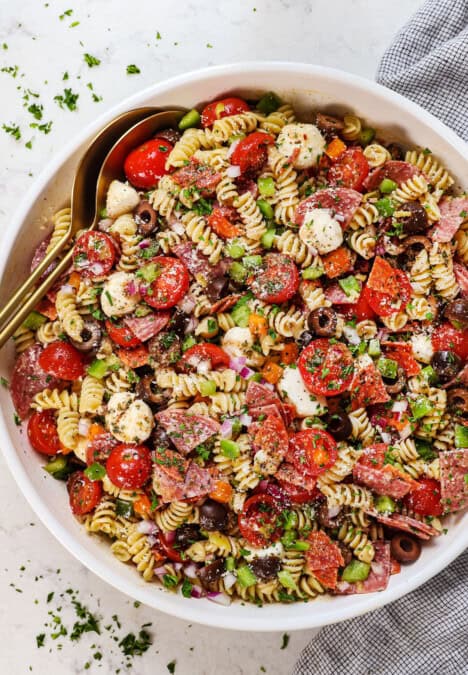
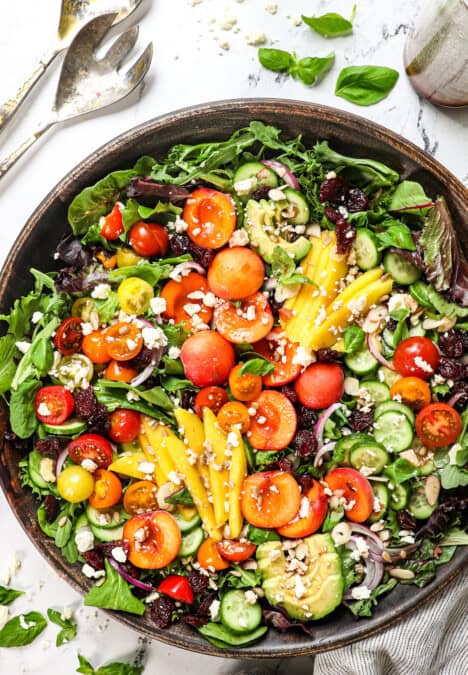
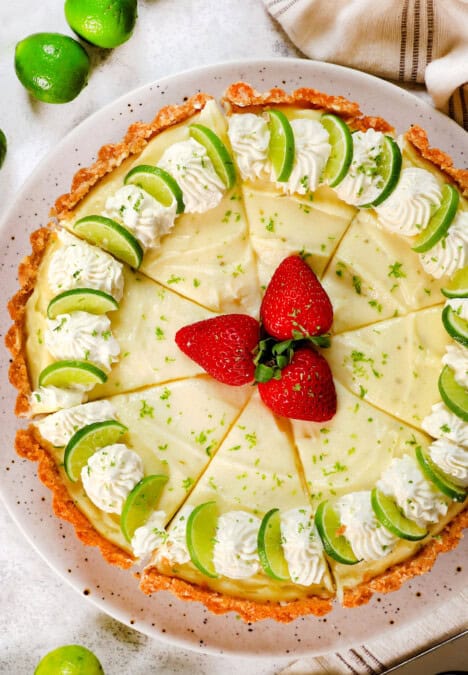























Katherine says
This looks fantastic, and I can’t wait to use it in January for a birthday cake. Do you have a recipe that includes a list of weights for the dry ingredients? Thank you.
Jen says
I don’t Katherine, but I will add shortly. Enjoy!
Tashy says
Can Meyer Lemons be used?
Jen says
Yes! Just adjust the lemon curd/frosting to taste.
Jane says
I don’t understand why the butter for the cake should be at room temperature. When you mix it, the butter is too soft to achieve that crumbly/coarse texture. My pieces of butter completely mushed together and immediately turned into a paste vs a crumbly batter, and this was before I even added the wet ingredients. What happened?
Jen says
Hi Jane, it sounds like your “room temperature” butter was too soft, it should still be cold to the touch. Here is a great article explaining it: https://sallysbakingaddiction.com/room-temperature-butter/
Laura says
I too would love to make this cake and prefer weighing dry ingredients. Is that information available please?
Jen says
I don’t have the weight measurements, sorry for the inconvenience!